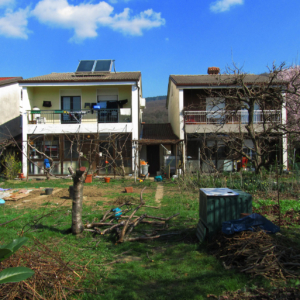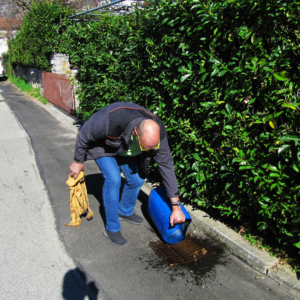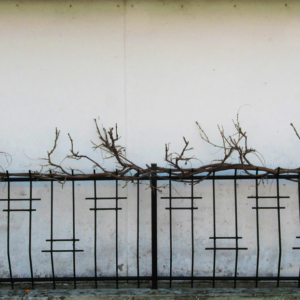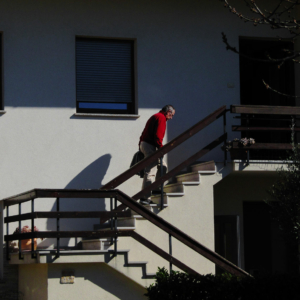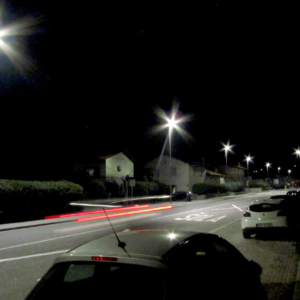Luka Carlevaris
3. letnik // Year 3 | Mentor: Tadej Žnidarčič
50 IN 100 METROV SOLKANA // 50 AND 100 METERS OF SOLKAN
To bo že tretja naloga za fotografsko serijo, ki sem jo ustvaril na temo svoje soseske. Če sem popolnoma iskren, je to po novem moja najhujša nočna mora, saj se še nisem srečal s težjim izzivom, kot pa poiskati zanimive in vizualno privlačne fotografije v kraju, ki ga vsakodnevno gledam. Tako kot je Pariz postal dolgočasen Bressonu, lahko rečem enako za svoj kraj. Kljub temu sem poskušal ustvariti, kar se da dobro serijo obrobja Solkana.
Mesto Solkan se nahaja zraven Nove Gorice, na repu naše »kokošje države«. Kljub svoji majhnosti se skozi Solkan prepletajo številne ulice in vsaka ima svojo posebno zgodbo, med katerimi so ene bolj in ene manj pomembne. Mogoče na žalost, bom jaz govoril o slednji, manj pomembni zgodbi. Na obrobju Solkana, skrita za hišami, ki gledajo na glavno cesto, leži Sočebranova ulica. To bo osmo leto, odkar smo se z družino vselili vanjo. Gre za sosesko, ki med lokalnimi prebivalci slovi predvsem po svoji umirjenosti in tišini, za razliko od neprestano burnega središča Nove Gorice. V bistvu bi se pravzaprav enako lahko reklo za celotno obrobje Solkana, katerega manjši predel predstavljam v svoji fotografski seriji. V Solkanu je ta del mesta znan tudi kot Žabji kraj; najbrž zaradi močvirja, ki se je nahajalo tu, preden se je mesto začelo širiti. Moje območje raziskave, katere meja je bila 100 metrov, je poleg Sočebranove ulice zaobsegla tudi njeno sosednjo ulico – Ulico Josipa Makuca.
Za začetek se bom osredotočil na svojo Sočebranovo ulico. Njeni prebivalci se večkrat radi pošalimo, da branimo Sočo. Ime namreč ni naključno, saj je naša ulica poimenovana po Andreju Komelu, plemenitem Sočebrranu, slovenskem časniku avstrijske vojske. Rodil se je 3. oktobra 1829 v Solkanu. Šolal se je v Gorici ter pri frančiškanih v samostanu Kostanjevica. V župnijski cerkvi v Solkanu je delal kot organist, dokler ni bil leta 1848 poklican v vojsko. Leta 1864 je napredoval v poročnika in pričel svojo enoto poučevati v slovenščini, saj je bilo v polku okrog 30 % Slovencev. V slovenščino je prevedel tudi najpotrebnejše vojaške priročnike in pravilnike ter tako olajšal slovenskim vojakom službovanje in napredovanje. Za njegovo delo mu je cesar Franc Jožef I. podelil plemiški naslov Sočebran. Upokojil se je leta 1886 kot častni major. Umrl je 12. novembra 1892 v Avstriji.
Podobno so na ime svoje ulice lahko ponosni prebivalci ulice Josipa Makuca. Bil je kemijski tehnolog, rojen 5. marca 1897, prav tako v Solkanu. Gimnazijo je končal v Gorici tik pred začetkom bojev na Soški fronti. Po koncu prve svetovne vojne je na Univerzi v Zagrebu študiral fiziko, kemijo in matematiko. Po končanem študiju je začel delati v kemični industriji v Karlovcu, Zagrebu in Celju. Raziskoval je tehnološke postopke, predvsem v anorganski kemiji in jih več patentiral. Eden njegovih največjih uspehov je bilo odkritje postopka pridobivanja čistega joda iz jodove vode, ki je tudi omogočil gradnjo tovarne joda v Sisku. Makuc je okoli leta 1950 skušal realizirati svoj postopek za predelavo bakrenih flotacijskih preparatov. V zadnjih letih življenja je težko bolehal in umrl 2. decembra 1958.
Obe ulici sta nastali po koncu druge svetovne vojne, ko so si Solkanci začeli postopoma graditi hiše. Ker so v času Jugoslavije imeli vsi to možnost, so hiše postavljali nesistematično, kar je privedlo do dveh slepih ulic. Tako kot marsikatera takrat novonastala ulica sta obe dobili ime po eni od pomembnih osebnosti. Večina njunih prebivalcev že presega starost 70 let, kar se kaže v umirjenosti in monotonosti vsakdana v soseski. Čeprav se občasno na ulici slišijo kriki otrok mlajših generacij, se tihi način življenja drži večine prebivalcev. Za nekoga, ki je priseljen v to sosesko, lahko to tudi potrdim. Kljub temu so ljudje še vedno izredno sramežljivi, zato jih je bilo zelo težko ujeti v objektiv. Osebno zelo težko povem še kaj več o svoji soseski, saj živim v kraju, ki na sploh ne slovi po dokaj dinamičnem dogajanju. Prebivalci obrobja Solkana se precej dobro poznamo, tako da se za vse zanimive dogodke hitro razve naokoli, zato težko verjamem, da bi izvedel kaj novega, če bi izbral kakšno drugo ulico. S tem nočem prikazati svoje soseske kot najbolj dolgočasne ulice na svetu, saj gre za izjemno dober kraj, kjer življenje gladko teče, a tu se tudi konča.
// This will be the third assignment for a photo series I’ve done on the topic of my neighborhood. Honestly, this is now my worst nightmare, as I have not yet faced a more difficult challenge than finding interesting and visually appealing photos in the area, I watch every day. Just as Paris has become boring to Bresson, I can say the same for my place. Nevertheless, I tried to create as good a series of this outskirts of Solkan as possible.
The town that lies next to Nova Gorica on the tail of our “chicken country”. Despite their small size, many streets intertwine through Solkan and each has its own special story, some more noteworthy than others. I will unfortunately be talking about one that belongs to the latter. On the outskirts of Solkan, hidden behind houses overlooking the main road, lies Sočebranova ulica. This will be our eighth year since my family moved into it. The neighborhood, which is famous among its inhabitants mainly for its tranquility and silence, in contrast to the constantly turbulent center of Nova Gorica. In fact, the same could be said for the entire outskirts of Solkan, a smaller part of which I present in my photographic series. In Solkan, this part of the town is also known as Žabji kraj, probably because of the swamp that was located here before the town began to expand. My research area, the limit of which was 100 meters, in addition to Sočebranova Street, also included its neighbor Josipa Makuca Street.
For a start, I will focus on my Sočebran. Its inhabitants often like to joke that we are defending the Soča. The name is not accidental, as our street is named after Andrej Komel, the noble Sočebrran, a Slovenian newspaper of the Austrian army. He was born on October 3, 1829 in Solkan. He was educated in Gorizia and with the Franciscans in the Kostanjevica monastery. He worked as an organist in the parish church in Solkan until he was drafted into the army in 1848. In 1864 he was promoted to lieutenant and began teaching his unit in Slovene, as in the regiment about 30% of the entire team was of the Slovene nation. He also translated the most necessary military manuals and rules into Slovene, thus making it easier for Slovene soldiers to serve and advance. For his work, Emperor Franz Joseph I awarded him the noble title of Sočebran. He retired in 1886 as an honorary major. He died on November 12, 1892 in Austria.
Similarly, the residents of Josipa Makuc Street can be proud of the name of their street. He was a chemical technologist, born March 5, 1897, also in Solkan. He finished high school in Gorizia just before the fighting on the Isonzo Front. After the end of the First World War, he studied physics, chemistry and mathematics at the University of Zagreb. After finishing his studies, he started working in the chemical industry in Karlovac, Zagreb and Celje. He researched technological processes, especially in inorganic chemistry, and patented several of them. One of his greatest successes was the discovery of the process of extracting pure iodine from iodine water, which also enabled the construction of an iodine factory in Sisak. Around 1950, Makuc tried to realize his process for processing copper flotation preparations. In the last years of his life, he became seriously ill and died on December 2, 1958.
Both streets were built after the end of World War II, when the people of Solkan gradually began to build houses. Since in the time of Yugoslavia everyone had this option, houses were erected unsystematically, which led to two dead ends. Like many of the newly created streets at the time, both were named after one important personality. Most of their inhabitants are already over the age of 70, which is reflected in the calmness and monotony of everyday life in the neighborhood. Although the cries of children of younger generations are occasionally heard on the street, the quiet way of life is adhered to by most residents. For someone who has moved into a neighborhood, I can also confirm this. Nevertheless, people are still extremely shy, so it was extremely difficult to catch them in the lens. Personally, it is very difficult to say anything more about my neighborhood, as I live in a place that is not at all famous for its rather lush events. The inhabitants of the outskirts of Solkan know each other quite well and all the interesting events quickly spread around, so I find it hard to believe that I would find out anything new if I chose another street. By not wanting to portray my neighborhoods as the most boring streets in the world, it’s an extremely good place where life flows smoothly, but that’s also where it ends.
